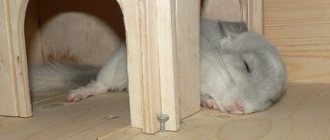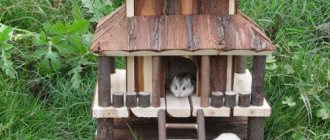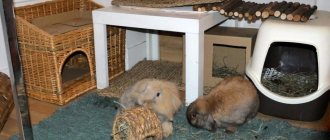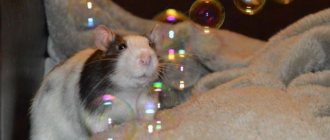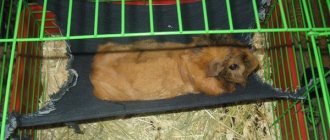What can you make a house for a rat from?
When choosing a material, there are several nuances to consider:
- the material should not attract rats as a food product;
- you need to choose environmentally friendly options so as not to harm your pet’s health;
- the surface must be easy to clean and wash - this will help avoid unpleasant odors.
There is a whole list of suitable options. You can build a rat house with your own hands from the following materials:
- plywood;
- plastic;
- clay;
- textile;
- knitted options;
- glass.
You can combine several types of materials with each other, creating entire residences for your pet.
Interesting ideas for houses made from scrap materials
If you don’t have a lot of time or special desire to make a home for your pet, then you can use improvised devices. The process will take a few minutes, and you may only need a utility knife to make it.
You can make a house for a rat with your own hands using improvised tools in a few minutes like this:
- A plastic food tray will make a wonderful house; just cut out a passage and several windows in the walls of the dish;
- if you have the remains of Lego at home, then in a few minutes you can build a comfortable “villa” for your pet;
- an old parcel box is a simple and environmentally friendly option for building a home;
- a clay pot or an old cup laid on its side is an original option that will appeal to the rodent and the person who will clean the house.
Depending on the shape and size, it is easy to select other options for construction: a chandelier shade, a vase, a teapot, a small teapot, and so on.
The easiest way to create a home for a rat
No matter how paradoxical it may be, the easiest way to make a house is using the papier-mâché technique. The design can have any shape, size, color. The set of materials and tools is minimal: a mold for the product, a roll of toilet paper or a pack of napkins, water, a brush and a little time.
How to make a house for a rat with your own hands using the papier-mâché technique?
- Install the prepared form.
- Tear napkins or toilet paper into thin strips.
- Lightly moisten the strips of paper in water and place them on the prepared form.
- You need to make sure that the shape is not visible through the paper, and that the cellulose layer is sufficient to hold the shape.
The paper will dry within 24 hours. Then you should carefully remove the form, you will get a wonderful house. You can use a utility knife to cut holes for windows and entrances. If desired, you can paint your home with safe paints.
What to equip
Rats are very energetic animals; structures for climbing and other active games must be placed in the house: ladders, shelves, tunnels. Unlike their other rodent brethren, they are indifferent to the spinning wheel and are not worth purchasing.
First of all, build a “nest”; an ordinary cardboard box with a drilled hole will do for its manufacture. In such a shelter, your tailed friend will feel comfortable and safe, relax and sleep. Place paper and small rags on the bottom; they will be used for home improvement. If you want to please your pet, buy a nest in the form of a ball, hanging basket or hammock; rats love them very much.
An option for real needlewomen - a closed knitted hammock
Knitted houses for rats, created by yourself, are an option that will allow you to create colorful and comfortable housing for your pet. A knitted house is called a hammock. The hammock can be closed or open.
The principle of creating a closed hammock:
- The easiest way to create a design is with a hook. It is advisable to use acrylic threads for knitting.
- Knitting starts from the bottom. You can make the bottom double and put a piece of plywood in the resulting pocket.
- It is possible to knit in the round or knit individual parts and then sew them. The simplest option is circular knitting.
- It is worth casting on five air loops and closing them in a circle. Next, knit several rows adding 1 loop to each row. The number of such rows is determined by the desired size. This knitting will allow you to form the floor of the house.
- After making the bottom of the house, you can start knitting the walls. Rows are knitted without additions. Their number will determine the lifting height for the move.
- You need to count 10 loops and do not knit them until the opening is formed.
- Then the unknitted loops are closed using a chain of air loops.
- The roof is knitted in the same way as the floor. Only instead of adding loops in each row, a decrease is made.
In order not to think about how to shape the product using various frames, you can simply hang the hammock at several points. The house will stretch and take on the desired shape.
How to make it yourself?
It is not necessary to purchase a ready-made hammock for your pet at a pet store. Store-bought products are not always of good quality and reasonable price. From available materials you can make a good and reliable model of the required size. During production, a number of recommendations should be taken into account.
- There is no need to try to save free space in the cage and make a bed that is too compact. It is better if the hammock is 2 or more times wider than a rodent.
- It is best to use metal objects, such as paper clips and chains, as fasteners for the product. Such fastenings will be more reliable than a simple rope, which a rat can easily chew through.
- The fabric from which the hammock will be made must not only be durable, but also safe from a toxic point of view. If it was painted with harmful dyes, then the pet may get poisoned. It is best to use natural types of fabrics rather than synthetics.
- Metal parts can only be used as fasteners, but not as the main canvas for the bed. A metal mesh is stronger than fabric; an animal is unlikely to chew through it and ruin it, but it can injure the pet. In addition, metal is too hard and cold material, so the rodent will be uncomfortable and uncomfortable on such a hammock.
From jeans
Using old denim clothes is one of the easiest ways to make a hammock for rats. In this case, you don’t even need to pick up a needle, thread and sew. All you need to make a hammock is:
- unnecessary jeans;
- stationery scissors;
- ruler or measuring tape;
- a small piece of old soap;
- metal chain or paper clips.
It will take no more than 10 minutes to make a denim bed. It is best to use old wide men's jeans. You need to measure 25 centimeters from the bottom edge of the trouser leg and mark the cut with a bar of soap. Then you need to cut a piece from the trouser leg and start making fasteners.
The number of staples in the chain will depend on the height at which you plan to hang the hammock. The materials used must be quite strong so that the fasteners can withstand the weight of the decorative rat. Chains or staples are threaded through one layer of jeans at the four corners of the cut piece. After this, you can place the bed in the cage and attach it to the metal bars. The rodent can be placed on the lounger either on top or inside the trouser leg itself.
Out of the hood
You can convert a hood from an unnecessary item into a hammock for a rodent. In this case, the process will take a little more time and effort than when making a denim couch. In addition to the hood itself, you should first prepare the following things:
- stationery scissors;
- sewing machine or regular needle and thread;
- large diameter metal wire that will serve as a frame.
If the hood was originally attached to a sweater or jacket with a zipper, then it must be cut off. To create a hole for the wire, the uneven edge must be bent 1-1.5 centimeters and stitched well. A metal wire is inserted into the hole, after which the edges need to be sewn up. A canopy hammock is usually made in the shape of a bag. To do this, the edges of the hood, which were located closer to the face, are sewn together. The finished product can be attached to the cage using sewn ties made of thick rope or on a chain of paper clips.
From a piece of fabric
To make a hammock, you can use a single piece of fabric. You can purchase it at the store or use old unnecessary things. For example, you can fold a pillowcase, sheet or towel several times and sew up the edges. If the material will be purchased in a store, it is best to buy fleece or cotton fabric. The size of the piece of fabric must be selected in accordance with the dimensions of the cage and the animal. As a standard, you can use a canvas of 30x60 centimeters. In addition to the hammock base, you will need the following things:
- needle and thick threads;
- stationery scissors;
- fittings (eyelet with washer) for edging holes;
- a hammer or special pliers and a hole punch for installing eyelets;
- hooks designed for shower curtains in the bathroom.
From the two narrowest sides of the rectangular piece you need to fold 1 centimeter of fabric and sew up the folds. The stitched ends need to be connected to each other in the center of a piece of fleece or other material. Next you need to sew the long edges. The resulting fabric must be turned inside out through the hole in the center.
You need to install eyelets in the four corners of the piece of fabric. Then hooks are inserted into the holes reinforced with fittings, after which the hammock can be hung in the rodent cage.
Methods for finishing finished pet houses
It’s not enough to make a house for a rat with your own hands, you also need to decorate your pet’s home. This technique will give the cell an unusual look. It will seem that the cage is a separate dwelling, a house within a house.
Photos of houses for rats, made by hand by some craftsmen, are stunning in their appearance. You can find entire castles, huts, and villas. This effect can be achieved through decorative design.
The home can be painted, burned, or covered with thread or fabric. Attach rat toys to the walls or secure rings for them to run into.
What is it needed for
Does a rat really need a house? Experts insist that the animal must have its own secluded corner. Let's try to figure out the reasons.
First of all, it is necessary to note the stressful situations that can happen to an animal due to many factors. A stranger, loud noises, sudden movements - all this can frighten the animal, and it will want to hide.
In the absence of such an opportunity, even tame rats can experience attacks of aggression and panic, which in severe cases lead to health problems.
While providing comfortable conditions for a pet, owners need to take care that the cage is not exposed to drafts. Rats can be very sensitive to them and often get colds. A house with windproof walls will allow you to hide inside and not get sick. Also, in an insulated house you can easily hide from the cold, even in an apartment where, for some reason, the temperature is quite low. If direct sunlight hits the cage, rats, on the contrary, can hide in a shelter from the heat.
The rat feels safe in the shelter . This is especially important if the animal is not feeling well. Calmer males feel much more comfortable without a house, while girls, on the contrary, need protection and a secluded corner.
Secrets of experienced house makers
Before making a house for a rat, it is worth considering several features of certain parameters:
- the height of the structure should be such that the rat cannot reach the ceiling while standing on its hind legs;
- the width and length of the room are made such that the rat can freely fit in a lying position;
- The entrance should be wide, but not too wide, the pet should pass through unhindered, and the person should be able to easily clean inside.
Other recommendations may relate to the type of material (we mentioned this above). As you can see, making a home for a small rodent with your own hands is not only easy, but also interesting.
Accessories for the cage
When caring, you need to think about the physical and mental health of your pets.
Rats are intellectually developed creatures. They need toys, hammocks to sleep in, places to wait out danger, and materials to sharpen their teeth. Toys and objects for incisors need to be changed frequently, otherwise your pets will get bored with them.
When choosing a wheel-style treadmill, make sure it is large enough for your rat, but does not take up too much space in the cage. Buying a cardio wheel is not a requirement. As rodents grow up, they lose interest in running on wheels.
Read also: The meaning of the word “lamb” in 12 dictionaries
There should be a solid and heavy container for food in the cage, and a drinking bowl with at least 0.5 liters of water should be hung between the bars.


